
Heimskringla is the best known of the Old Norse kings' sagas. It was written in Old Norse in Iceland by the poet and historian Snorri Sturluson (1178/79–1241) c. 1230. The name Heimskringla was first used in the 17th century, derived from the first two words of one of the manuscripts.
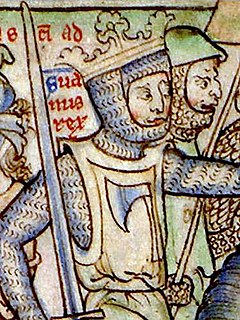
Sweyn Forkbeard was king of Denmark from 986 to 1014. He was the father of King Harald II of Denmark, King Cnut the Great and Queen Estrid Svendsdatter.

Olof Skötkonung, sometimes stylized as Olaf the Swede, was King of Sweden, son of Eric the Victorious and, according to Icelandic sources, Sigrid the Haughty. He succeeded his father in c. 995. He stands at the threshold of recorded history, since he is the first Swedish ruler about whom there is substantial knowledge. He is regarded as the first king known to have ruled both the Swedes and the Geats. In Sweden, the reign of king Olov Skötkonung is considered to be the transition from the Viking age to the Middle Ages, because he was the first Christian king of the Swedes, who were the last to adopt Christianity in Scandinavia. He is associated with a growing influence of the church in what is today southwestern and central Sweden. Norse beliefs persisted in parts of Sweden until the 12th century.
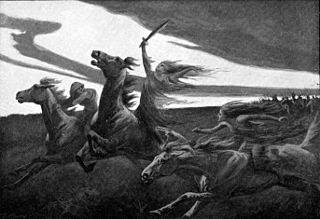
In Norse mythology, a dís is a deity, ghost, or spirit associated with Fate who can be either benevolent or antagonistic toward mortals. Dísir may act as protective spirits of Norse clans. It is possible that their original function was that of fertility goddesses who were the object of both private and official worship called dísablót, and their veneration may derive from the worship of the spirits of the dead. The dísir, like the valkyries, norns, and vættir, almost always are referred to collectively in surviving references. The North Germanic dísir and West Germanic Idisi are believed by some scholars to be related due to linguistic and mythological similarities, but the direct evidence of Anglo-Saxon and Continental German mythology is limited. The dísir play roles in Norse texts that resemble those of fylgjur, valkyries, and norns, so that some have suggested that dísir is a broad term including the other beings.

Eric the Victorious was a Swedish monarch as of around 970. Although there were earlier Swedish kings, he is the first Swedish king in a consecutive regnal succession, who is attested in sources independent of each other, and consequently Sweden's list of rulers usually begins with him. His son Olof Skötkonung, however, is considered the first ruler documented to definitely have been accepted both by the original Swedes around Lake Mälaren and by the Geats around Lake Vättern. Adam of Bremen reports a king named Emund Eriksson before Eric, but it is not known whether he was Eric's father, and the Norse sagas' accounts of a Björn Eriksson are considered unreliable.

A runestone is typically a raised stone with a runic inscription, but the term can also be applied to inscriptions on boulders and on bedrock. The tradition began in the 4th century and lasted into the 12th century, but most of the runestones date from the late Viking Age. Most runestones are located in Scandinavia, but there are also scattered runestones in locations that were visited by Norsemen during the Viking Age. Runestones are often memorials to dead men. Runestones were usually brightly coloured when erected, though this is no longer evident as the colour has worn off. Most runestones are found in present-day Sweden.

Sigrid the Haughty, also known as Sigrid Storråda (Swedish), is a queen appearing in Norse sagas. Sigrid appears in many late Icelandic sagas composed generations after the events they describe, but there is no reliable evidence correlating to her story as they describe her. She is sometimes listed as wife of Eric the Victorious of Sweden, then Sweyn Forkbeard of Denmark, while more contemporary sources such as Thietmar of Merseburg and Adam of Bremen instead claim that Sweyn was married to a Polish princess, identified as Świętosława. Snorri Sturluson gives conflicting information and in one place says that Sweyn was married to Sigrid and in another that he was married to a Gunhild of Wenden.
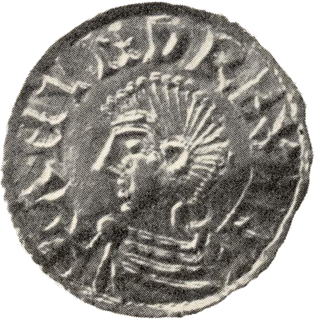
Anund Jacob or James, Swedish: Anund Jakob was King of Sweden from 1022 until around 1050. He is believed to have been born on July 25, in either 1008 or 1010 as Jakob, the son of King Olof Skötkonung and Queen Estrid. Being the second Christian king of the Swedish realm, his long and partly turbulent reign saw the increasing dissemination of Christianity as well as repeated attempts to influence the balance of power in Scandinavia. Through out his regin he tried to subvert the raising Danish hegemony in Scandinavia by supporting the Norwegian monarchy. He also supported the reign of Yaroslav the Wise in Kievan Rus, his brother-in-law. He is referred to in positive terms in German and Norse historical sources. His reign was one of the longest in Sweden during the Viking age and Middle Ages.

The House of Stenkil was a dynasty on the Swedish throne from c. 1060 to c. 1125. Stenkil probably originated from Västergötland.
Inge the Elder was a king of Sweden. In English literature he has also been called Ingold. While scant sources do not allow us to paint a full picture of his term of kingship, he is known to have led a turbulent but at length successful reign of more than two decades. He stands out as a devout Christian who founded the first abbey in Sweden and acted harshly against pagan practices. The kingdom was still an unstable realm based on alliances of noblemen, and Inge's main power base was in Västergötland and Östergötland; one of the earliest chronicles that mention his reign knows him as rex gautorum, king of the Geats.

Ragnvald Ulfsson the Old was a jarl of Västergötland or Östergötland and was married to a sister of King Olav Tryggvason.

Haakon Sigurdarson was the de facto ruler of Norway from about 975 to 995. Sometimes he is styled Hakon the Powerful through Ágrip af Nóregskonungasögum and Historia Norwegiæ gives the less flattering name Hákon Illi, that is Hakon Bad.
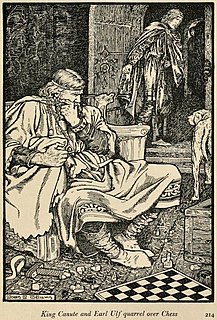
Ulf was a Danish earl (jarl) and regent of Denmark. Ulf was the son of Thorgil Sprakling and the father of King Sweyn II of Denmark and thus the progenitor of the House of Estridsen, which would rule Denmark from 1047 to 1375, which was also sometimes, specially in Swedish sources, referred to as the Ulfinger dynasty to honor him.
Erik Årsäll was a semi-historical king of Sweden. His historicity has been called into question. He is dated by some to the end of the 11th century, by others to the 1120s, while more critical historians believe that he is a legendary name belonging to the 10th century. According to some, he was the son of the pagan Swedish king Blót-Sweyn, and, like his father before him, administered the blóts at the temple at Uppsala. However, Erik does not appear in any Swedish or Danish primary sources.

Åsta Gudbrandsdatter was the mother of two Norwegian kings, King Olaf II of Norway and King Harald III of Norway. The primary source for the life of Åsta is Snorri Sturluson's saga Heimskringla, a 13th-century collection of tales about the lives of the Norwegian kings. In the chronicle, Åsta is described as "generous and high-minded" and as a keen political player and guiding influence on her royal husbands and children. Her parents were Gudbrand Kula and Ulfhild.
Harald Grenske was a petty king in Vestfold in Norway.

The Orkesta Runestones are a set of 11th-century runestones engraved in Old Norse with the Younger Futhark alphabet that are located at the church of Orkesta, northeast of Stockholm in Sweden.

Arson in medieval Scandinaviawas a technique sometimes employed in blood feuds and political conflicts in order to assassinate someone. In committing arson, a group of attackers would set fire to the home of an opponent, sometimes by quickly and surreptitiously piling wood, brush and other combustible materials against the exterior of a dwelling and set it on fire. Typically the attackers would surround the house to prevent the escape of its inhabitants, although women, the elderly, and small children were sometimes allowed to leave.

Ulf of Borresta was a runemaster in the eleventh century Uppland, Sweden, and a successful Viking who returned from England three times with a share of the Danegeld. He is named after his estate which in modern Swedish is called Borresta or Bårresta.
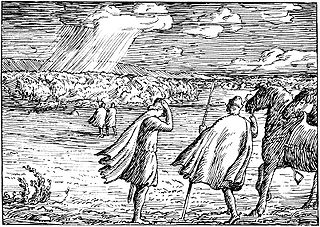
Kálfr Árnason was an 11th-century Norwegian chieftain who played a major role both in defeating King Olaf Haraldsson at the Battle of Stiklestad and in bringing back his young son Magnus and raising him to the throne.

















